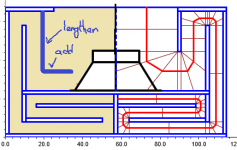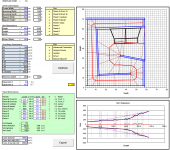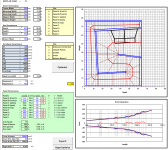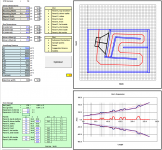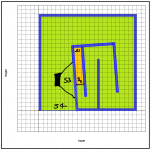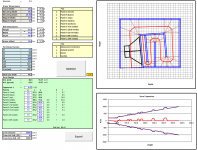My my, my myopic eyes see two external dimensions the same as the Keystone sub, and one between the original 45", and one smaller than the "B-Low" at 49.5"- but "close enough for rock & roll"- give the man a see-garr
Cheers,
Titanium Cranium
LOL, we've got a winner 🙂
I wanted to check to see if it was possible to get to 34 Hz and below with this fold using the dimensions of your KS THs.
At first, the answer appeared to be no.
Now, the answer might be "maybe", if I add a tweak and move the change in expansion from S3 to S4 (possible here because of how the horn is actually folded). I'm going to take a closer look tomorrow, but it does look possible, according to the sims. Basically the S4-S5 section is "too large" for the horn to get below 40 Hz, so the solution may be to reduce the expansion in that section by moving the change in expansion to S4.
The image below indicates what I'm considering at the moment.
Attachments
Nope, as one TH, as I couldn't figure out how to sim two cabinets with one driver 🙂.
As an educated guess you could do a two cabinet sim with a drop of three dog bones to make up for the missing dog boneificator.
No more coffee for me!
😱
Just a few updates to the THAM folding workbook. It now contains an optimization routine. To use it, you'll need to enter the driver and desired box dimensions and values for S1 and S5, then hit the "Optimize" button until the error cell reads zero. There's an Export routine included to have the workbook create a Hornresp file that can be input into Hornresp for further analysis.
I've also got ideal conical and exponential expansions for the horn's path length displayed in the expansion graph (as dotted lines), which can be used as a guide of trying to approximate one of those expansions. Once I figure out the equation to translate path length to csa for hyperbolic horns, I'll include that too.
I've also got ideal conical and exponential expansions for the horn's path length displayed in the expansion graph (as dotted lines), which can be used as a guide of trying to approximate one of those expansions. Once I figure out the equation to translate path length to csa for hyperbolic horns, I'll include that too.
Attachments
Hi Brian Steele,It now contains an optimization routine. To use it, you'll need to enter the driver and desired box dimensions and values for S1 and S5, then hit the "Optimize" button until the error cell reads zero.
Nice work, but where can we find it 🙂
Regards,
Djim
Hi Brian Steele,
Nice work, but where can we find it 🙂
Regards,
Djim
All of the latest versions of the workbooks can be found here: The Subwoofer DIY Page
I've updated the first message in the thread to reflect this. I thought it better to do it this way rather than to have nnn versions of the workbooks in the thread.
Hi Brian Steele,
Thanks, didn't see the first post. The link to your website, with an overview of all of your spreadsheets, is even more easy.
Regards,
Djim
Thanks, didn't see the first post. The link to your website, with an overview of all of your spreadsheets, is even more easy.
Regards,
Djim
Brain have you tried your talents on a front loaded horn yet?
FLHs are actually a bit more difficult to analyze than THs - many of them contain rear chambers with non-parallel walls, and it's a bit of a challenge to programmatically calculate the volume of those chambers. Plus, I haven't come across a FLH design yet that I feel the gumption to build 🙂.
Just a few updates to the THAM folding workbook. It now contains an optimization routine. To use it, you'll need to enter the driver and desired box dimensions and values for S1 and S5, then hit the "Optimize" button until the error cell reads zero. There's an Export routine included to have the workbook create a Hornresp file that can be input into Hornresp for further analysis.
Two more things:
1. I've added a feature that indicates the ideal horn width to result in the mouth that's square. Supposedly, after a circle, this is supposed to be the most efficient shape for the mouth.
2. The results of some playing around with the optimization feature suggests that there's one and only one solution for a THAM fold with a given throat and mouth size in a box with specified dimensions, even if it's a dual-expansion fold. Instinctively this seems to make sense to me, though it's nice to see that confirmed by the optimization routine. The THAM fold does allow for a lot of flexibility wrt the ratio between S1-S3 and S3-S5 though, more so than the SS-fold I believe allows, just by adjusting the ratio between the height and the depth of the box. This might just put it to the top of my favourite list.
...until perhaps I finish putting together a workbook to describe the Othorn fold, or at least a simplified version of the fold, which I think I'll tackle next.
Upgraded the THAM workbook to V3.1
1. Corrected the calculations for the exponential horn guide
2. Add a hyperbolic horn guide. For the example horn given in the workbook, I've adjusted the dimensions to emulate a hyperbolic horn in two steps.
Question: is there any particular value to approximating a hyperbolic flare for a bass horn that's going to do 100 Hz and below?
1. Corrected the calculations for the exponential horn guide
2. Add a hyperbolic horn guide. For the example horn given in the workbook, I've adjusted the dimensions to emulate a hyperbolic horn in two steps.
Question: is there any particular value to approximating a hyperbolic flare for a bass horn that's going to do 100 Hz and below?
Attachments
BrianS,
I see the input cabinet width is given as 36.8cm (368mm)
Further down I see "Ideal box width = 36cm"
What is this telling me?
Where does one enter the material thickness? I only see the box dimensions. External, or internal dims?
I see the input cabinet width is given as 36.8cm (368mm)
Further down I see "Ideal box width = 36cm"
What is this telling me?
Where does one enter the material thickness? I only see the box dimensions. External, or internal dims?
FLHs are actually a bit more difficult to analyze than THs - many of them contain rear chambers with non-parallel walls, and it's a bit of a challenge to programmatically calculate the volume of those chambers. Plus, I haven't come across a FLH design yet that I feel the gumption to build 🙂.
So you need a carrot. A raison d'etre. what be your wishes? And I'll make a design that gives you a reason for trying.
As a start there are a few folding methods that work with front loaded horns. The chamber nautilus type fold works well for horns around 40 hertz. When you get down to the nether reaches something with a form factor of roughly 1 to 5. Rectangular with the 1 being the width and the 5 being the length.
So ball is in your court. What is your dream horn?
BrianS,
I see the input cabinet width is given as 36.8cm (368mm)
Further down I see "Ideal box width = 36cm"
What is this telling me?
Cabinet width and mouth CSA are both manually input values. What that's telling you is if you set cabinet width to the computed ideal box width (36 cm in this case), the mouth of the horn will be square, given the CSA that you'd like to achieve with the sim.
Where does one enter the material thickness? I only see the box dimensions. External, or internal dims?
The panel thickness is entered in the green box that contains all of the panel dimensions. Where you see the box dimensions, that refers to the external dimensions.
I've updated the "SS" folding workbook to include optimization routines. Now all you need to do is enter the desired box dimensions and panel thickness (which needs to be entered for each panel), the values you'd like for S1 and S5, and whack away at the "Optimize!" button until the error cell reads "0.0". Then use export the Hornresp parameters for analysis in Hornresp.
This new version, v7.0 also corrects some minor bugs that were present in the previous version, v6.3. Unfortunately I had to remove the "cone compensation" routine that allowed to include cone compensation in the folding, but I plan to put that back in at a later date.
All of the workbooks can be found here: The Subwoofer DIY Page - Horn Folding
This is likely the last I'll be able to work on the workbooks for awhile - I'm back to work as of Thursday 🙂.
This new version, v7.0 also corrects some minor bugs that were present in the previous version, v6.3. Unfortunately I had to remove the "cone compensation" routine that allowed to include cone compensation in the folding, but I plan to put that back in at a later date.
All of the workbooks can be found here: The Subwoofer DIY Page - Horn Folding
This is likely the last I'll be able to work on the workbooks for awhile - I'm back to work as of Thursday 🙂.
Attachments
Maaping out the Othorn...
I've started putting together a workbook to cover the "Othorn" fold and I've already run into a little bit of an issue. At first glance it looks like a single-expansion TH, but a closer look shows that's not the case at all. It's basically an MTH30 type of fold, with an additional panel added near the throat, and that additional panel is what's throwing the expansion out.
After thinking about it a bit, I'm think going to treat L12 as a stub with no expansion and start the expansion from S2 through to S4. There's going to be a tiny bit of lost volume just after S2 as the expansion will be slightly pinched there, but I'm going to work out how much actual volume is "lost" and subtract it from the cone compensation required for the driver. That should bring the sim back into alignment with the layout of the horn in the workbook.
I didn't bother to include the slight increase in expansion that happens at the mouth. I suspect that would make very little difference to the sim. In the Othorn there's also an extra panel in the L12 area that reduces S1 significantly. I'm not sure of the purpose of this panel, so I've left it out for the moment. In any case, it should be very easy to modify the Hornresp sim generated by the workbook to include the effects of this panel.
I've started putting together a workbook to cover the "Othorn" fold and I've already run into a little bit of an issue. At first glance it looks like a single-expansion TH, but a closer look shows that's not the case at all. It's basically an MTH30 type of fold, with an additional panel added near the throat, and that additional panel is what's throwing the expansion out.
After thinking about it a bit, I'm think going to treat L12 as a stub with no expansion and start the expansion from S2 through to S4. There's going to be a tiny bit of lost volume just after S2 as the expansion will be slightly pinched there, but I'm going to work out how much actual volume is "lost" and subtract it from the cone compensation required for the driver. That should bring the sim back into alignment with the layout of the horn in the workbook.
I didn't bother to include the slight increase in expansion that happens at the mouth. I suspect that would make very little difference to the sim. In the Othorn there's also an extra panel in the L12 area that reduces S1 significantly. I'm not sure of the purpose of this panel, so I've left it out for the moment. In any case, it should be very easy to modify the Hornresp sim generated by the workbook to include the effects of this panel.
Attachments
The only thing i can think of is the little corner at the mouth.
Can you workbook this one?

😀😛
Midbass horn. And not gonna fit in Brian's car.
- Home
- Loudspeakers
- Subwoofers
- Spreadsheet for Folded Horn Layouts...

